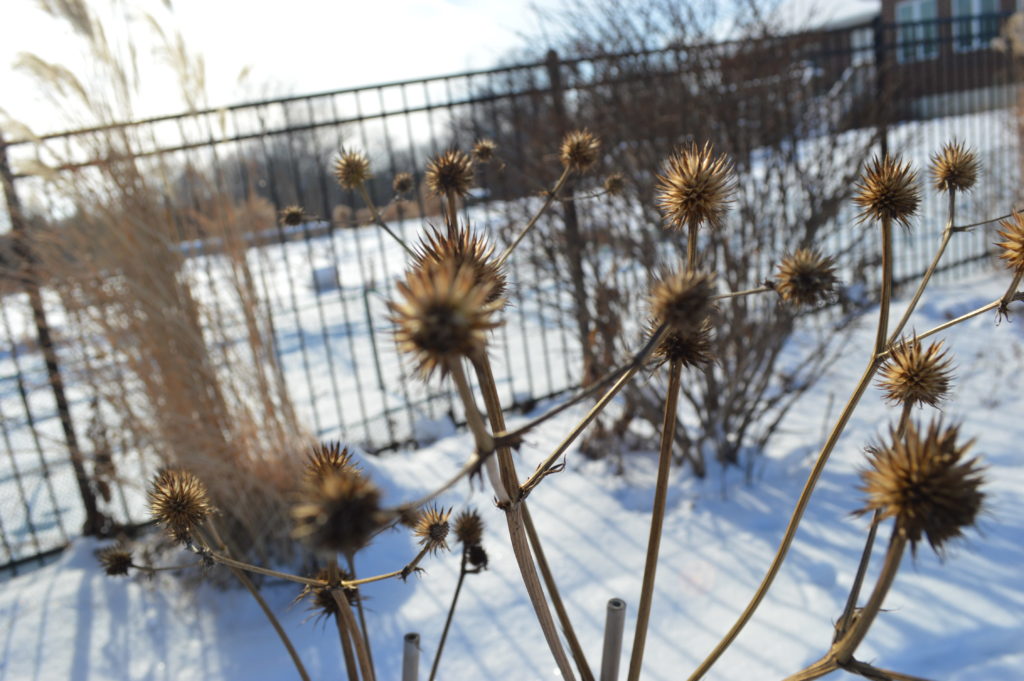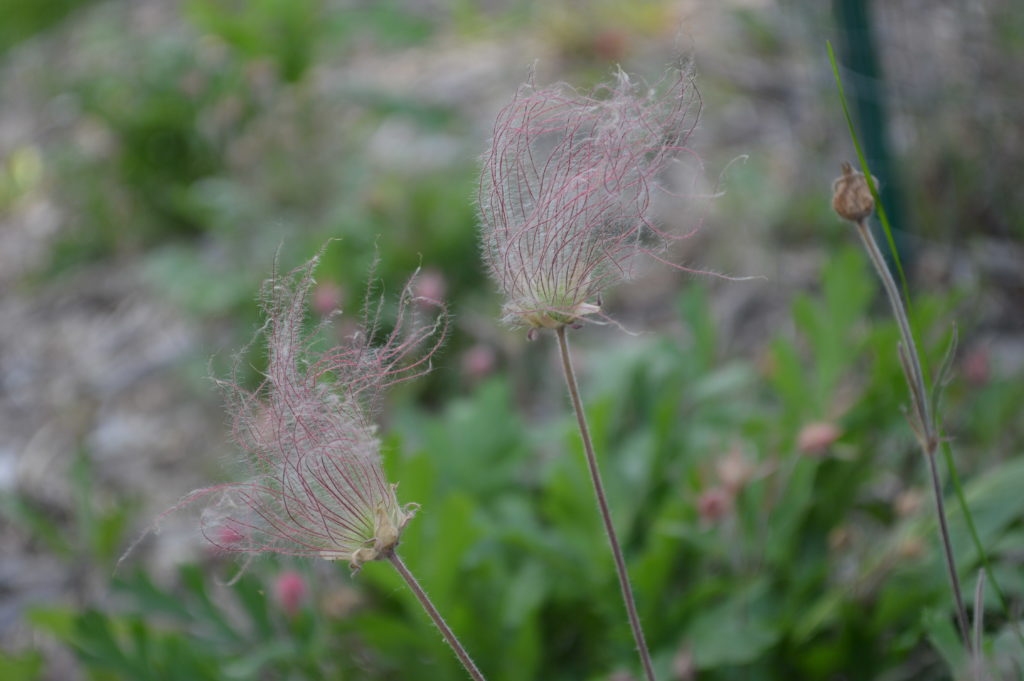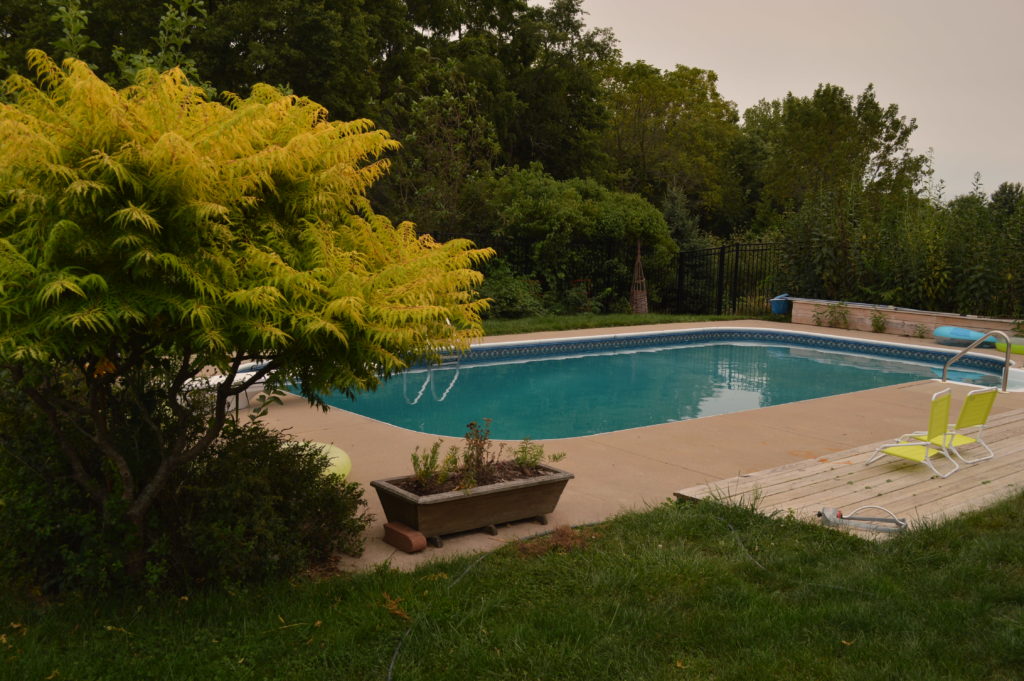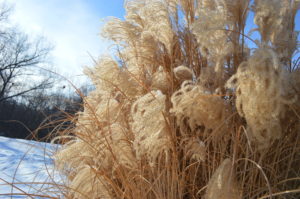
Rattlesnake master seed heads stand strong during winter at the rural Solon home of Cindy Reed and Steve Lamer. The native plant sports yucca-like foliage and small, dense spherical white flowers in early summer. (photo/Cindy Hadish)
By Cindy Hadish/for Iowa Gardener
Nearly two acres of turf grass continues its transformation into a nature-friendly habitat in rural Solon.
Cindy Reed and her husband, Steve Lamer, have been working on that evolution for seven years, with a design by Iowa City-based Backyard Abundance to create a sustainable landscape featuring fruit trees and bushes, native grasses, vegetables and perennials.
Both work full time and preferred not to spend their free time mowing the 1.8 acres surrounding their home in the rolling subdivision, a nearly day-long process. They also wanted a more environmentally sustainable landscape.

Silver-spotted skippers are attracted to blue salvia, while the thicker-leaved comfrey, at left, also provides benefits for pollinators. (photo/Cindy Hadish)
In stepped Backyard Abundance, led by director Fred Meyer, which aims to teach residents how to take steps to transform the outdoors into spaces that work in harmony with nature.
Using principles of permaculture, a form of sustainable agriculture, thousands of individual seedlings were planted, such as pear, apple, paw-paw and nut trees, gooseberry, raspberries, elderberry, yarrow, ginger, sage and comfrey, a medicinal herb. While some, such as the paw-paw trees, have yet to fruit, others, including the raspberries, have been highly productive.
Fencing and plant cages keep hungry deer and rabbits at bay, for the most part, Reed said, and many of the beds are now self-sustaining, requiring less maintenance.
Strawberry beds produce bright red fruits, green beans climb rustic willow trellises and bees buzz flower-to-flower on low-growing lamium and dangling bell-shaped comfrey flowers. A walk through pillow-like thyme – the landscape’s main groundcover – releases the plants’ aromatic scent.
“We’re still implementing and maintaining. It’s been a lot of fun, a lot of learning, a lot of work,” Reed said. “Mother Nature is so interesting. It’s a constant negotiation with nature.”
Her step-daughter, Karen Lamer, performs much of the management on weed control and other maintenance.
Pointing out “volunteers,” Lamer noted that pollinator-friendly plants, such as milkweed, essential for the life cycle of monarch butterflies, are allowed to grow.
“Wherever it volunteers, that’s where it’s the happiest,” she said.
While Lamer cited a need to hand-remove weeds – they don’t like to use herbicides or pesticides on the grounds – for the most part, the landscape is serving its purpose.
“The main thing is, the flowers are blooming and they support the pollinators and that’s what we want,” she said.
Reed agreed.
“I’m so glad we did it,” she said. “We’ve learned a lot, but I wouldn’t trade the experience for anything.”
See more photos below and in the November/December 2018 edition of the Iowa Gardener magazine. Find extensive information on gardening in Iowa by subscribing to the Iowa Gardener.
Learn about other great Iowa gardens:
Wanda Lunn grows new and old in harmony
Daylily gardens in Central City
Rustic acres in southeastern Iowa
Inner-city haven in Cedar Rapids

Feathery styles of prairie smoke billow in the breeze at the rural Solon home of Cindy Reed and Steve Lamer. The spring bloomer is among the natives planted at the couple’s home. (photo/Cindy Hadish)

A dwarf Tiger Eyes sumac tree, at left, anchors the edge of the swimming pool in the backyard of Cindy Reed and Steve Lamer. The tree’s chartreuse foliage changes to vibrant yellow, with long red cones in midsummer. (photo/Cindy Hadish)


No Comments Yet